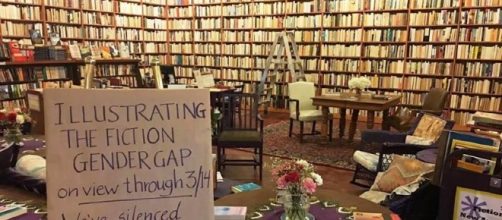One bookstore hopes to send an important message!
Earlier this month, Loganberry Books in Cleveland made a dramatic illustration by turning all books written by men backwards and only displaying books written by women. The transformation, which ran parallel to Women’s History Month, sends a very clear message: male Writers severely outnumber female writers, suggesting that women occupy a less important role in the world of print.
But the problem isn’t just a lack of female writers; it’s the fact that many of the female writers that do make it onto the shelf wind up being excluded from larger arenas.
Is the publishing world really as gender biased as it seems?
It wasn’t long ago that women writers had to adopt male pseudonyms to get published; Mary Anne Evans wrote Middlemarch and Adam Bede using the pen-name George Eliot to ensure that her work would be taken seriously; the famous Brontë sisters (Charlotte, Anne, Emily) wrote under their married names Currer, Ellis and Acton Bell; even Joanne Rowling, author of the world-famous Harry Potter books, used the pen-name J. K. Rowling to get her foot through the door.
Now, more than one hundred years later, and female writers still face the same issues. Some really good writers even run the risk of being ‘pigeon-holed’ into specific markets. I’m thinking of JoJo Moyes and Kate Morton – two writers who have completely dominated the popular fiction market, but are still attached with unfavourable labels like ‘chick-lit’.
What do the figures say?
In April 2014, the American organisation Vida conducted a study using data from a variety of literary publications. The results from the study confirmed a disproportional number of male to female writers: London Review of Books, for example, reported that of the authors reviewed, 192 were men in comparison to 58 women.
This was only slightly better than last year, when 245 men were reviewed in comparison to 72 female writers.
What, then, do these numbers suggest? Well, if a history of successful female writers is indicative of anything, it’s that women play a vital role in the world of literature. Why, then, don’t these numbers reflect the facts with parity?
Feminist activism - paving the way for new talent
Since the 1950s, periods of feminist activism have helped to shed some light on the matter. Considered revolutionary at the time of publication, classics like Kate Millet’s Sexual Politics have since become essential reading for contemporary feminists who are working to keep the movement alive. Those same feminists aren’t just reading the classics, though. They’re also writing and lending their perspective to new books on the movement. I’m thinking, in particular, about Chimamanda Ngozi Adichie’s We Should All Be Feminists: throwing down the gauntlet, she argues that we do need Feminism, and that we should all be feminists.
But, the figures still stand: women writers are being pushed into the background, while male writers continue to storm our bookshelves. So I wonder, what are the parameters for selecting books for publishing these days? Maybe, the time has come to start looking more closely at the quality of writing more than anything else.

